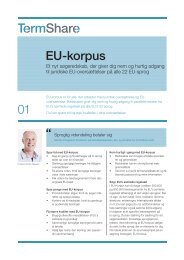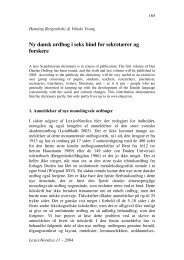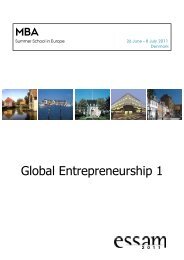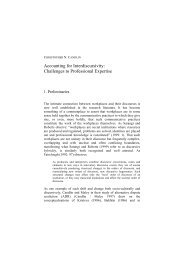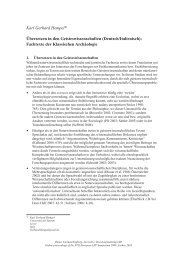The Workflow of Computer-Assisted Translation Tools in
The Workflow of Computer-Assisted Translation Tools in
The Workflow of Computer-Assisted Translation Tools in
Create successful ePaper yourself
Turn your PDF publications into a flip-book with our unique Google optimized e-Paper software.
Localisation tools can also be <strong>in</strong>cluded under the more sophisticated group <strong>of</strong> CAT tools. Localisation<br />
is understood <strong>in</strong> broad terms as “the process <strong>of</strong> chang<strong>in</strong>g the documentation <strong>of</strong> a product,<br />
a product itself or the delivery <strong>of</strong> services so that they are appropriate and acceptable to the<br />
target society and culture” (Quah 2006: 19). Examples <strong>of</strong> localisation tools are Corel Catalyst,<br />
Passolo, AppLocalize, etc. For a more detailed defi nition <strong>of</strong> localisation and discussion <strong>of</strong> its state<br />
<strong>in</strong> the <strong>in</strong>dustry, see Essel<strong>in</strong>k (2000 and 2003) and Pym (2004).<br />
CAT tools have proven to be extremely useful for the pr<strong>of</strong>essional (particularly technical)<br />
translator, who can <strong>in</strong>crease productivity and quality as well as speed <strong>of</strong> delivery to the client.<br />
However, translators must <strong>in</strong>vest time, effort and sometimes money <strong>in</strong> tra<strong>in</strong><strong>in</strong>g themselves to use<br />
such tools. Further, CAT tools liberate the translator from many tedious tasks such as formatt<strong>in</strong>g,<br />
document layout, etc, so that the translator can concentrate on the translation per se. This is how<br />
high quality translations can be achieved at an <strong>in</strong>creas<strong>in</strong>gly shorter time.<br />
2.2. Mach<strong>in</strong>e translation (MT)<br />
In MT, the task <strong>of</strong> analys<strong>in</strong>g and decod<strong>in</strong>g the source texts corresponds to the mach<strong>in</strong>e, but the<br />
human operator may carry out pre-edit<strong>in</strong>g or post-edit<strong>in</strong>g tasks. <strong>The</strong> translations produced <strong>in</strong> this<br />
way are also very fast, but typically <strong>of</strong> low quality. As Hutch<strong>in</strong>s and Somers (1992: 149) state,<br />
“we can have either fully automatic translation or high quality translation but we cannot have<br />
both”.<br />
Quality <strong>in</strong> many MT systems, however, is not the ma<strong>in</strong> goal. Instead, these systems can provide<br />
a ‘rough’ or ‘<strong>in</strong>dicative’ translation, sometimes referred to as gist translation. This is especially<br />
useful <strong>in</strong> the case <strong>of</strong> long source texts, where MT programs can be used to determ<strong>in</strong>e which portion<br />
<strong>of</strong> the source text would warrant pr<strong>of</strong>essional translation, which takes us back to CAT tools.<br />
This is how CAT and MT have been happily co-exist<strong>in</strong>g <strong>in</strong> the translation <strong>in</strong>dustry. Examples <strong>of</strong><br />
MT systems <strong>in</strong>clude SYSTRAN (general MT), SPANAM and ENGSPAN (specialised MT), etc.<br />
However, some MT systems can produce very high quality translations. This is possible <strong>in</strong> specialised<br />
contexts with controlled <strong>in</strong>put, such as MÉTÉO <strong>in</strong> Canada, which translates from English<br />
<strong>in</strong>to French and French <strong>in</strong>to English <strong>in</strong> the doma<strong>in</strong> <strong>of</strong> meteorology. In the specifi c doma<strong>in</strong> <strong>of</strong><br />
health <strong>in</strong> Lat<strong>in</strong> America, SPANAM and ENGSPAN translate from English <strong>in</strong>to Spanish and Spanish<br />
<strong>in</strong>to English respectively (see L<strong>of</strong>fl er-Laurian 1996: 21). <strong>The</strong>se two examples illustrate that,<br />
<strong>in</strong>stead <strong>of</strong> reach<strong>in</strong>g for high-quality general MT, the way forward may lie <strong>in</strong> high-quality specialised<br />
MT. By tak<strong>in</strong>g the skopos, or purpose, <strong>of</strong> the translation <strong>in</strong>to account, we can achieve highquality<br />
output <strong>in</strong> the particular context where it is needed (see ten Hacken 2001).<br />
3. Typical workfl ow with CAT tools<br />
In this section, I describe <strong>in</strong> simple terms the typical use <strong>of</strong> CAT tools <strong>in</strong> a specialised translation<br />
scenario. <strong>The</strong> workfl ow described here is generic to most CAT tools, rather than focused on a particular<br />
CAT tool, and it can be equally applied to freelance translators work<strong>in</strong>g <strong>in</strong>dividually and to<br />
translators work<strong>in</strong>g as part <strong>of</strong> a team. Because CAT tools are usually s<strong>of</strong>tware packages consist<strong>in</strong>g<br />
<strong>of</strong> a number <strong>of</strong> programs that can <strong>in</strong>teract between them or work as standalone programs, describ<strong>in</strong>g<br />
the workfl ow <strong>of</strong> the specialised translation process with a visual image (see fi gure 1 below) is<br />
useful <strong>in</strong> that it allows us to see at a glance how the results <strong>of</strong> certa<strong>in</strong> parallel tasks are the basis<br />
for the successful performance <strong>of</strong> subsequent tasks.<br />
3.1. Visualis<strong>in</strong>g the workfl ow<br />
A visual image <strong>of</strong> the workfl ow is given <strong>in</strong> fi gure 1 below, where we can trace the source text<br />
from the moment the client commissions the translation until the fi nished product is handed to the<br />
client. Figure 1 is broadly divided <strong>in</strong>to three sections, namely Before translation, ‘Dur<strong>in</strong>g translation’<br />
and ‘After translation’, but <strong>in</strong> practice the boundaries between each section may not be as<br />
clear-cut. Because the workfl ow <strong>in</strong> the translation process is centred around the source text, the<br />
3



